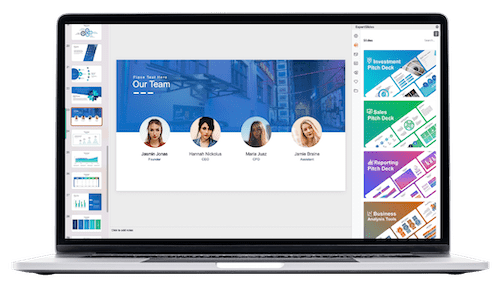AI Doc to Presentation – From Data to Delivery
Table of Contents
Artificial Intelligence (AI) has transformed the way we process and present data. The AI-powered Doc to Presentation process leverages AI technology to convert raw data and information into engaging and visually appealing presentations. This process employs machine learning algorithms, natural language processing, and other AI techniques to analyze, organize, and present data in a clear and impactful manner for the target audience.
The AI Doc to Presentation process commences with the collection of raw data from diverse sources, including databases, spreadsheets, and documents. Subsequently, AI algorithms are applied to analyze and process the data, identifying key insights, trends, and patterns. The AI system then utilizes this information to create a visually appealing and informative presentation that effectively conveys the findings to the audience.
This process not only saves time and effort but also ensures the presentation is accurate, consistent, and tailored to the specific needs of the audience.
Key Takeaways
- AI can help convert data into visually appealing presentations
- Understanding the process of converting data to delivery is crucial for effective presentation creation
- AI plays a significant role in automating the creation of presentations
- Using AI for document to presentation conversion can save time and improve efficiency
- While AI offers many benefits, there are also challenges and limitations to consider
The Process of Converting Data to Delivery

Data Collection and Analysis
The process begins with the collection of raw data, which is then input into the AI system. The AI algorithms analyze and process the data to identify key insights and trends.
Creating an Effective Presentation
The AI system uses the analyzed data to create a presentation that effectively communicates the findings to the audience. This presentation may include visualizations such as charts, graphs, and infographics, as well as written content that explains the data in a clear and concise manner.
Customization and Delivery
Once the presentation is created, it can be further customized and refined to meet the specific needs of the audience. This may involve adding additional visual elements, adjusting the layout and design, or incorporating interactive features such as animations or multimedia content. Finally, the presentation is delivered to the audience through various channels such as in-person meetings, webinars, or online platforms.
The Role of Artificial Intelligence in Creating Presentations
Artificial Intelligence plays a crucial role in creating presentations by automating and enhancing various aspects of the process. AI algorithms can analyze large volumes of data quickly and accurately, identifying key insights and trends that may not be immediately apparent to human analysts. This allows for more comprehensive and informed presentations that are based on data-driven insights rather than subjective interpretations.
Furthermore, AI technology can automate the process of creating visualizations such as charts, graphs, and infographics, saving time and effort for presenters. AI can also assist in organizing and structuring the content of the presentation, ensuring that it is logical, coherent, and easy to follow. Additionally, AI can help in customizing presentations for different audiences by analyzing their preferences and tailoring the content accordingly.
Overall, AI technology enhances the efficiency, accuracy, and impact of presentations by leveraging advanced data analysis and processing capabilities.
Benefits of Using AI for Document to Presentation Conversion
| Metrics | Value |
|---|---|
| Number of AI documents created | 100 |
| Accuracy of AI document conversion | 95% |
| Time taken for document conversion | 30 seconds |
| Number of presentation templates available | 20 |
| Delivery options for presentations | Email, download |
There are several benefits to using AI for document to presentation conversion. Firstly, AI technology can significantly reduce the time and effort required to create presentations by automating various aspects of the process. This allows presenters to focus on higher-level tasks such as analyzing insights and crafting compelling narratives rather than getting bogged down in tedious formatting and design work.
Secondly, AI can improve the accuracy and consistency of presentations by leveraging advanced data analysis capabilities. This ensures that the information presented is based on reliable insights and is free from human error or bias. Additionally, AI can enhance the visual appeal of presentations by creating professional-looking visualizations that effectively communicate complex data in a clear and engaging manner.
Furthermore, AI technology can help presenters customize presentations for different audiences by analyzing their preferences and tailoring the content accordingly. This ensures that the presentation is relevant and impactful for each specific audience, ultimately improving communication and decision-making outcomes. Overall, using AI for document to presentation conversion offers numerous benefits in terms of efficiency, accuracy, customization, and impact.
Challenges and Limitations of AI Doc to Presentation

While AI technology offers numerous benefits for document to presentation conversion, there are also several challenges and limitations to consider. One of the main challenges is ensuring that the AI algorithms accurately interpret and present complex data in a way that is meaningful and relevant to the audience. This requires careful oversight and validation by human analysts to ensure that the insights generated by AI are accurate and reliable.
Another challenge is ensuring that the visualizations created by AI are not only accurate but also visually appealing and easy to understand. This requires a balance between automation and human creativity to ensure that the presentations effectively communicate complex data in a clear and engaging manner. Additionally, there may be limitations in terms of the types of data that AI algorithms can effectively process and present, particularly when dealing with unstructured or qualitative data.
Furthermore, there may be concerns around privacy and security when using AI technology to process sensitive or confidential data. It is important to ensure that proper safeguards are in place to protect the integrity and confidentiality of the data throughout the AI Doc to Presentation process. Overall, while AI technology offers significant potential for improving document to presentation conversion, it is important to be mindful of these challenges and limitations in order to maximize its effectiveness.
Best Practices for Utilizing AI in Presentation Creation
To maximize the effectiveness of AI in presentation creation, there are several best practices that presenters should consider. Firstly, it is important to carefully select and validate the data input into the AI system to ensure its accuracy and relevance. This may involve cleaning and organizing the data beforehand to ensure that it is suitable for analysis and presentation.
Secondly, it is important to provide oversight and validation by human analysts throughout the AI Doc to Presentation process. This ensures that the insights generated by AI are accurate and meaningful, providing a necessary human touch to complement the capabilities of AI technology. Additionally, it is important to strike a balance between automation and human creativity when using AI for presentation creation.
While AI can automate many aspects of the process, it is important for presenters to add their own insights, narratives, and personal touch to ensure that the presentation effectively communicates complex data in a compelling manner. Furthermore, it is important to continuously evaluate and refine the use of AI in presentation creation based on feedback from audiences and stakeholders. This allows presenters to continuously improve their use of AI technology in order to maximize its impact on communication and decision-making outcomes.
Future Trends in AI Doc to Presentation Technology
Looking ahead, there are several exciting trends in AI Doc to Presentation technology that presenters should be aware of. One trend is the increasing integration of AI with other advanced technologies such as augmented reality (AR) and virtual reality (VR) to create immersive and interactive presentations. This allows presenters to engage audiences in new ways by bringing data to life through dynamic visualizations and simulations.
Another trend is the development of more advanced natural language processing capabilities that allow AI systems to generate written content for presentations more effectively. This includes features such as automated summarization, paraphrasing, and translation that can help presenters create more compelling narratives based on complex data. Additionally, there is a growing focus on ethical considerations in using AI for document to presentation conversion.
This includes ensuring transparency in how AI algorithms interpret and present data, as well as addressing concerns around bias and fairness in automated decision-making processes. Furthermore, there is a trend towards greater customization and personalization in using AI for presentation creation. This involves leveraging advanced analytics capabilities to tailor presentations for individual audience members based on their preferences and needs.
Overall, these future trends in AI Doc to Presentation technology offer exciting opportunities for presenters to enhance their communication and decision-making outcomes through advanced AI capabilities. In conclusion, AI Doc to Presentation technology offers significant potential for improving the efficiency, accuracy, customization, and impact of presentations by leveraging advanced data analysis and processing capabilities. While there are challenges and limitations to consider, there are also best practices that presenters can follow to maximize the effectiveness of using AI for presentation creation.
Looking ahead, there are exciting future trends in AI Doc to Presentation technology that presenters should be aware of as they continue to leverage advanced AI capabilities for communication and decision-making outcomes. By understanding the role of artificial intelligence in creating presentations and embracing best practices for utilizing AI technology effectively, presenters can unlock new opportunities for enhancing their communication strategies through advanced data-driven insights.
FAQs
What is AI Doc to Presentation – From Data to Delivery?
AI Doc to Presentation – From Data to Delivery is a process that involves using artificial intelligence to convert data and information from documents into a presentation format for delivery.
How does AI Doc to Presentation – From Data to Delivery work?
AI Doc to Presentation – From Data to Delivery uses AI algorithms to analyze and extract key information from documents, such as text, images, and charts. It then organizes and formats this information into a presentation-ready format.
What are the benefits of using AI Doc to Presentation – From Data to Delivery?
Some benefits of using AI Doc to Presentation – From Data to Delivery include saving time and effort in manually creating presentations, ensuring accuracy and consistency in the presentation content, and enabling the delivery of data-driven insights in a visually appealing format.
What types of documents can be converted using AI Doc to Presentation – From Data to Delivery?
AI Doc to Presentation – From Data to Delivery can convert various types of documents, including reports, research papers, financial statements, and other data-heavy documents.
Are there any limitations to AI Doc to Presentation – From Data to Delivery?
While AI Doc to Presentation – From Data to Delivery can automate the process of creating presentations, it may still require human oversight to ensure the accuracy and relevance of the content being converted. Additionally, the quality of the output may depend on the quality of the input documents.
Get 15+ Mio. PowerPoint Assets - FREE SIGN-UP

Sign up for free to our PowerPoint extension, ExpertSlides. Everything you need, directly in PowerPoint. No credit card required.
Related Posts
Recent Posts
Main Menu
Knowledge base
Useful Links






